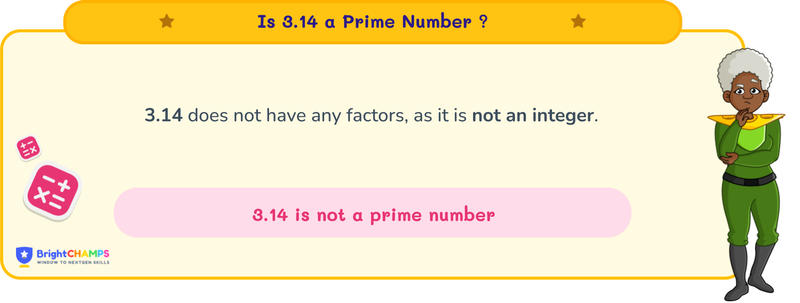Summarize this article:
 215 Learners
215 LearnersLast updated on August 5, 2025
Is 3.14 a Prime Number?

The numbers that have only two factors, which are 1 and itself, are called prime numbers. For encryption, computer algorithms, barcode generation, prime numbers are used. In this topic, we will be discussing whether 3.14 is a prime number or not.

Is 3.14 a Prime Number?
There are two types of numbers, mostly —
Prime numbers and composite numbers, depending on the number of factors.
A prime number is a natural number greater than 1 that is divisible only by 1 and itself.
For example, 3 is a prime number because it is divisible by 1 and itself.
A composite number is a natural number that is divisible by more than two numbers.
For example, 6 is divisible by 1, 2, 3, and 6, making it a composite number.
Prime numbers follow a few properties like:
- Prime numbers are positive integers greater than 1.
- 2 is the only even prime number.
- They have only two distinct factors: 1 and the number itself.
- Any two distinct prime numbers are co-prime numbers because they have only one common factor, which is 1.
As 3.14 is not a natural number, it cannot be classified as a prime number.

Why is 3.14 Not a Prime Number?
The characteristic of a prime number is that it is a natural number greater than 1 with exactly two divisors: 1 and itself.
Since 3.14 is not a natural number, it cannot be considered a prime number.
Here are a few methods used to distinguish between prime and non-prime numbers, though they apply only to integers:
- Counting Divisors Method
- Divisibility Test
- Prime Number Chart
- Prime Factorization

Using the Counting Divisors Method
The method in which we count the number of divisors to categorize numbers as prime or composite is called the counting divisors method. Based on the count of the divisors, we categorize prime and composite numbers.
- If there is a total count of only 2 divisors, then the number is prime.
- If the count is more than 2, then the number is composite.
For 3.14, since it is not a whole number, it does not fit into this classification method.
Explore Our Programs



Using the Divisibility Test Method
We use a set of rules to check whether a number is divisible by another number completely or not. It is called the Divisibility Test Method.
For integers:
Divisibility by 2: A number is divisible if its last digit is even.
Divisibility by 3: A number is divisible if the sum of its digits is divisible by 3.
Divisibility by 5: A number is divisible if its last digit is 0 or 5.
As 3.14 is not an integer, divisibility rules do not apply.

Using Prime Number Chart
The prime number chart is a tool created by using a method called “The Sieve of Eratosthenes.”
In this method, we follow these steps:
- Write numbers from 1 to 100 in a grid.
- Leave 1 without marking, as it is neither prime nor composite.
- Mark 2 because it is a prime number and cross out all the multiples of 2.
- Mark 3 because it is a prime number and cross out all the multiples of 3.
Through this process, we obtain a list of prime numbers from 1 to 100.
Since 3.14 is not an integer, it is not included in this list.

Using the Prime Factorization Method
Prime factorization is a process of breaking down a number into its prime factors.
For an integer:
- Start by dividing the number by the smallest prime number and continue the process with the quotient until it cannot be divided further by a prime number.
Since 3.14 is not a whole number, it cannot be factorized using prime factorization.

Common Mistakes to Avoid When Determining if 3.14 is Not a Prime Number
Children might have some misconceptions about prime numbers when they are learning about them. Here are some mistakes that might be made by children.

FAQ on is 3.14 a Prime Number?
1.Is 3.14 a natural number?
2.Can a decimal number be a prime number?
3.What is a prime number?
4.What are the factors of 3.14?
5.Is 3 a prime number?

Important Glossaries for "Is 3.14 a Prime Number"
- Decimal numbers: Numbers that contain a fractional part, represented with a decimal point, like 3.14. Natural numbers: The set of positive integers starting from 1, used for counting.
- Prime numbers: Natural numbers greater than 1 that have no divisors other than 1 and itself.
- Composite numbers: Natural numbers greater than 1 that have more than two distinct positive divisors.
- Divisibility rules: Rules used to determine if one integer is divisible by another without performing division.



Hiralee Lalitkumar Makwana
About the Author
Hiralee Lalitkumar Makwana has almost two years of teaching experience. She is a number ninja as she loves numbers. Her interest in numbers can be seen in the way she cracks math puzzles and hidden patterns.
Fun Fact
: She loves to read number jokes and games.

















